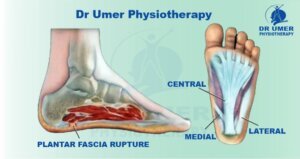It is a thick band of fibrous connected tissue that connects from the base of the calcaneus and it also known as the heel bone. It mixes all the way into the toes. The main role of the plantar fascia is to support the arch of the foot. If you increase loads whether it be weight gain or increase in activity such as running or long term standing so, you start putting pressure down through the arch of the foot and that causes a stretching of the plantar fascia. As time goes on it creates micro trauma or tears which will lead to the inflammation and pain and it is related with Plantar Fasciitis. Now normally patient come complains of heel pain which is located at the attachment site of the plantar fascia. Because the calcaneus situated along the length of the arch, in this case there is inflammation and pain also.
Symptoms
- Extreme pain when first steps in the morning.
- Pain in the palpation of calcaneal region.
- Usually pain in one foot.
- Feel burning or numbness in the foot.
- Pulling or ache in the bottom of the foot.
- Thickness of achilles tendon and gastrocnemius muscles
Causes
Plantar fasciitis is not usually the result of heel spurs. Doctors thought that heel spurs caused pain in people with plantar fasciitis, but this is not the case.
Plantar fasciitis develops as a result of overstretching or overuse of this ligament, although tears or small tears in the fascia tissue can also cause pain.
The texture of your feet can also put you at risk for developing P.F.
Those peoples working hard between the ages of 45 to 65 are at the higher risk of developing P.F.
Tight calf muscle also the cause of plantar fasciitis.
Risk Factors
The two main risk factors that cause the plantar fasciitis are;
- Lack of ankle range of motion especially lack of ankle dorsiflexion.
- Standing in long time like seven to eight hours.

Role of Physiotherapy for Plantar Fasciitis
Physiotherapist helps you to diagnose the reason of heel pain. The diagnosis is depends on symptoms, causes and your daily routine work. Physical therapist will see your calf muscles tightness and also the ankle range of motion. Physiotherapist can also palpate the suspect area to diagnose the reason of pain. If he think your fascia may have torn or your pain is coming from another reason, they may do x-ray or an MRI.
After diagnosing, physiotherapist also suggest you thing which you have to avoid. Physical exercises play a key role. The goal is to increasing the blood flow to the affected area which helps to speed up the healing process. Physiotherapist manage your pain with heat or ice therapy, massage therapy, ultrasonic therapy, electric-therapy and the most important stretching and strengthening exercises.
Exercises for Plantar Fasciitis
- Plantar Fascia Stretch
- Heel Raise
- Wall Calf Stretch
- Toe Curl
- Bottle Roll
Precautions
For avoiding pain follow the precautions.
- Walk with smaller steps
- Don’t walk barefoot
- Avoid jogging or running or other stress activities
- Lose weight (if you are overweight)
- Do stretching of your calves and feet
- Take a proper rest


